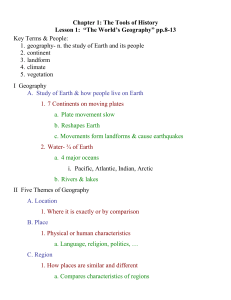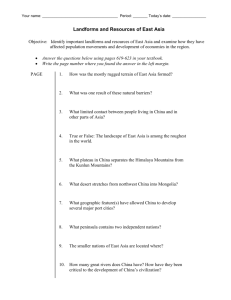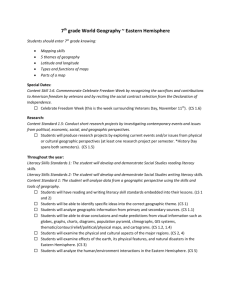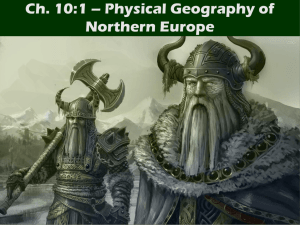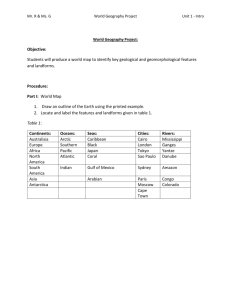Subject - Currituck County Schools
advertisement
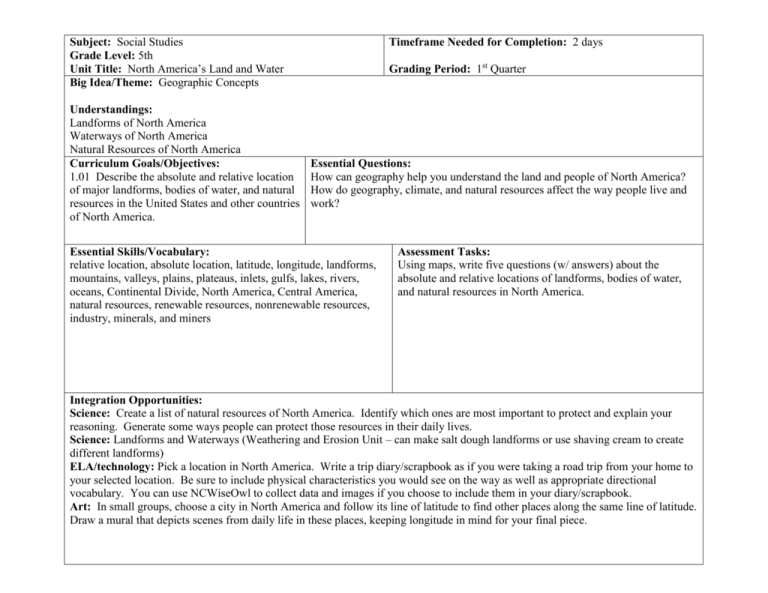
Subject: Social Studies Grade Level: 5th Unit Title: North America’s Land and Water Big Idea/Theme: Geographic Concepts Understandings: Landforms of North America Waterways of North America Natural Resources of North America Curriculum Goals/Objectives: 1.01 Describe the absolute and relative location of major landforms, bodies of water, and natural resources in the United States and other countries of North America. Timeframe Needed for Completion: 2 days Grading Period: 1st Quarter Essential Questions: How can geography help you understand the land and people of North America? How do geography, climate, and natural resources affect the way people live and work? Essential Skills/Vocabulary: relative location, absolute location, latitude, longitude, landforms, mountains, valleys, plains, plateaus, inlets, gulfs, lakes, rivers, oceans, Continental Divide, North America, Central America, natural resources, renewable resources, nonrenewable resources, industry, minerals, and miners Assessment Tasks: Using maps, write five questions (w/ answers) about the absolute and relative locations of landforms, bodies of water, and natural resources in North America. Integration Opportunities: Science: Create a list of natural resources of North America. Identify which ones are most important to protect and explain your reasoning. Generate some ways people can protect those resources in their daily lives. Science: Landforms and Waterways (Weathering and Erosion Unit – can make salt dough landforms or use shaving cream to create different landforms) ELA/technology: Pick a location in North America. Write a trip diary/scrapbook as if you were taking a road trip from your home to your selected location. Be sure to include physical characteristics you would see on the way as well as appropriate directional vocabulary. You can use NCWiseOwl to collect data and images if you choose to include them in your diary/scrapbook. Art: In small groups, choose a city in North America and follow its line of latitude to find other places along the same line of latitude. Draw a mural that depicts scenes from daily life in these places, keeping longitude in mind for your final piece. Subject: Social Studies Grade Level: 5th Unit Title: Living in North America Big Idea/Theme: Geographic Concepts Timeframe Needed for Completion: 2 days Grading Period: 1st Quarter Understandings: Location and Climate affects home, work, and recreation Urban versus rural characteristics Curriculum Goals/Objectives: Essential Questions: 1.02 Analyze how absolute and relative location How can geography help you understand the land and people of North America? influence ways of living in the United States and Is if better to live in one place versus another? Explain. other countries of North America. 1.05 Explain how and why population distribution differs within and between countries of North America Essential Skills/Vocabulary: Climate, transportation routes, population distribution, population density, rural, and urban Assessment Tasks: Imagine that you are writing to a friend who lives on the Pacific coast. Describe how your way of life may be different from his or hers because of where you live. Integration Opportunities: Technology: Pick three most populated cities in North Carolina. Using the Internet (start with NC WiseOwl), find climate information and population density for each. ELA/Writing: In order to harvest the oil that lies beneath the ocean, large drills must be placed in the water. These drills are operated on oil platforms, or large structures built in the water that reach all the way down to the seafloor. Given current events and our location from urban areas, is it right to drill for oil? Explain your thinking for either side you choose of the debate. Subject: Social Studies Grade Level: 5th Unit Title: Regions in North America Big Idea/Theme: Geographic Concepts Timeframe Needed for Completion: 2 days Grading Period: 1st Quarter Understandings: Regions can be determined by physical landforms, cultural connections, or economic status North America has a wide variety of landforms and cultures The United States is one of the richest nations in the world Curriculum Goals/Objectives: Essential Questions: 1.03 Compare and contrast the physical and How can geography help you understand the land and people of North America? cultural characteristics of regions within the Which country is the best? United States and other countries in North America. 1.04 Describe the economic and social differences between developed and developing regions in North America. Essential Skills/Vocabulary: Assessment Tasks: Region, culture, physical characteristics, geographers, diverse, On a large index card, write the name of a country in North European settlers, American Indians, Hispanics, Asian American, America on one side and a description of (physical, cultural, or traditions, deserts, rain forests, Mayans, economy, per capita economic) characteristics of that country on the other side. income, developed countries, developing countries, health care Integration Opportunities: Math/technology : graphing and data analysis connection/can use Excel chart wizard also ELA/research: select a developing country and research (NC WiseOwl) their lifestyle (jobs, recreation, school, etc.). Present your information either in a report of brochure format. Subject: Social Studies Grade Level: 5th Unit Title: People and the Land Big Idea/Theme: Geographic Concepts Timeframe Needed for Completion: 2 days Grading Period: 1st Quarter Understandings: People affect the physical environment around them. People adapt to their physical environment. Curriculum Goals/Objectives: 1.06 Explain how people of the United States and other countries of North America adapt to, modify, and use their physical environment. Essential Questions: How can geography help you understand the land and people of North America? Do we have a right to mold our environment? Essential Skills/Vocabulary: physical environment, adapt(ions), lightweight, low-lying, stilts, steep, timber industry, sod, modify, factories, tunnels, Panama Canal, locks, channels, dams, reservoirs, generators, border, public land, private land, and ruins Assessment Tasks: Imagine that you are writing to a friend who lives in Central America. Tell your friend how you adapt to your physical environment in North Carolina. Integration Opportunities: Technology/research: Have students use the Internet to research (NC WiseOwl) how people across North Carolina and the southeastern United States have adapted to and modified their physical environment. Ask students to identify at least one activity that shows adaptation to the physical environment and one activity that shows modification of the physical environment. Technology/research: In small groups research (NC WiseOwl) and make a flowchart that shows and labels the key parts of the Hoover Dam. Include all steps of the process from water to energy. Subject: Social Studies Grade Level: 5th Unit Title: Movement in North America Big Idea/Theme: Geographic Concepts Timeframe Needed for Completion: 3 days Grading Period: 1st Quarter Understandings: People often move from place to place. People have developed ways to trade goods and communicate ideas. Curriculum Goals/Objectives: Essential Questions: 1.07 Analyze the past movement of people, How can geography help you understand the land and people of North America? goods, and ideas within and among the United Why do we communicate with others? States, Canada, Mexico, and Central America and compare it to movement today. Essential Skills/Vocabulary: Influence, trade, goods, ideas, exchange, migration, homeland, opportunities, drought, immigration, immigrants, steam engines, power boats, locomotives, railroad engines, highways, markets, wagon, telegraph, radio broadcasts, Internet, and e-mails Assessment Tasks: Gather pictures/images of how people, goods, and ideas move today. Write a paragraph to make predictions about how you think people, goods, and ideas will move in the future. Using these items create a time capsule to share with classmates. Integration Opportunities: Media/Technology: In small groups have students research an invention to learn exactly how it works and different ways it is used. Create a PowerPoint presentation with your information.. Interview: Interview either a parent, grandparent, neighbor, etc. asking them what it was like to take a road trip when (s)he was a kid. Using that information compare and contrast what it is like today when you take a road trip with your family. You can either use a Venn diagram, a foldable, or a written explanation. (You can also use the above idea concerning record players vs. ipods, rotary phones vs. cell phones, etc.)


